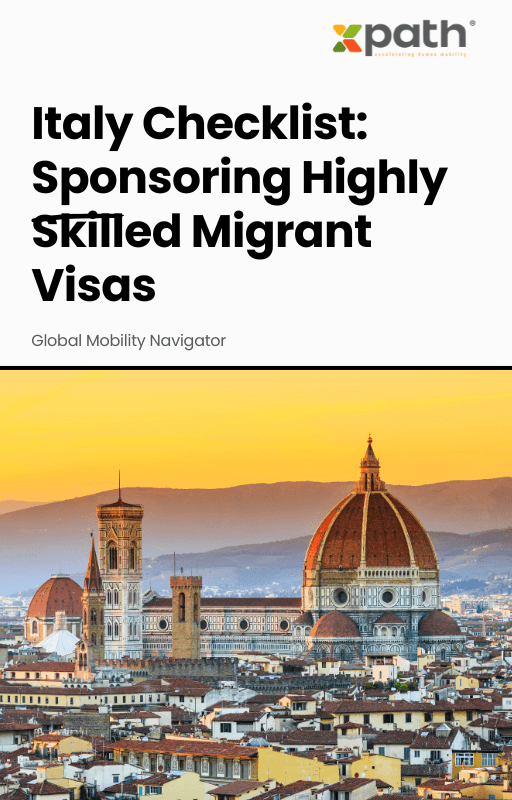Italy Checklist: Sponsoring Highly Skilled Migrant Visas
Grab a copy of a guide to international employee relocation
View E-bookGlobal mobility isn’t just a corporate buzzword—it’s the glove that fits the hand of modern business expansion. As organizations navigate hyper-connected, talent-hungry markets, sending the right people to the right place can mean the difference between thriving and merely surviving. But here’s the kicker: managing these assignments end-to-end is no easy feat. Should you trust a single, unified platform or embrace a mosaic of specialist tools? Let’s pull back the curtain on global mobility solutions, sift through some data, and find out what actually works.
Have you noticed the world feels both bigger and smaller all at once? As businesses set their sights on emerging markets, mobilizing top talent across borders is not just a strategy—it’s a necessity. In fact, a 2023 Deloitte survey revealed that over 70% of multinationals expect employee mobility demand to increase in the next three years. The question isn’t whether you’ll send employees on international assignments, but how seamlessly you’ll manage everything from visa processing to payroll and relocation support. A clunky, scattershot approach can torpedo morale and productivity; a nimble, integrated strategy can turbocharge growth.
Let’s talk tech. Many organizations still juggle multiple niche tools: one for visa compliance, another for expense management, another for relocation. It’s like herding cats (not fun). According to PwC’s 2022 Mobility Survey, almost 45% of companies admit to managing assignments with three or more disparate systems. The result? Data silos, manual errors, endless email threads, and frustrated teams.
Enter the all-in-one mobility platform—a solution designed to corral every touchpoint (think immigration, tax, housing, and reporting) under one digital roof. Platforms like xpath.global are leading the way, marrying all assignment management needs with automation and analytics. Companies can finally ditch the tangled web of spreadsheets and portals for a single source of truth.
So, does integration pay off? Absolutely. According to a recent Mercer study, companies that utilize a unified platform for mobility management reduce administrative time by as much as 30%—freeing HR teams to focus on employee experience and strategic planning.
Take the case of a tech giant that adopted an end-to-end global mobility solution. Within a year, they slashed time-to-deploy by 25%, eliminated 80% of manual data entry, and increased assignee satisfaction scores by double digits. These aren’t just incremental improvements—they’re game changers in a fiercely competitive talent market.
Here’s where the story gets real. More moving parts inevitably means more chances for things to go awry: regulatory hiccups, payroll nightmares, cost overruns, and compliance blind spots. The World Economic Forum flagged talent mobility and flexibility as a top competitiveness driver, but only if handled correctly.
The old-school model—patching together a handful of generic tools—can’t keep up. Why? Because every assignment is a complex dance of legal, financial, and cultural factors. Without centralized visibility and automation, it’s like conducting an orchestra with a dozen different sheet music arrangements. And instead of harmony… well, you’ll hear the discord.
One platform to rule them all isn’t just a catchy phrase; it’s the road to sanity in the mobility maze. Solutions like xpath.global offer HR and mobility leaders end-to-end control, real-time analytics, and customizable workflows. No more chasing paperwork, no more information black holes. The best part? These platforms can scale with you, supporting everything from single projects to enterprise-wide programs in 190+ countries.
What’s under the hood? Integrated compliance, digital document storage, policy automation, assignment tracking, and on-demand reporting. Employees enjoy a smoother move; HR enjoys fewer headaches; leadership gets clear insights to guide future talent deployments. It’s a win-win-win.
If your mobility program is stuck in the 2010s, it’s time to evolve. Start by taking stock: Are your current processes slowing down deployments? Are you losing sight of compliance risks? Are your people grumbling about the lack of support? Modern all-in-one solutions like xpath.global take the pressure off your teams and deliver a best-in-class experience for assignees—without drowning you in a sea of logins and systems.
Here’s the golden rule: fewer platforms mean less confusion, fewer errors, and a clearer view of every move, every cost, every outcome. Isn’t it time you aligned your mobility strategy with the pace of global business?
A global mobility solution is an integrated platform or system that streamlines all aspects of moving employees internationally, including compliance, logistics, visa management, relocation, and ongoing assignment support.
Using one unified platform reduces manual work, improves data integrity, simplifies reporting, and boosts both employee satisfaction and operational efficiency.
If your team struggles with manual tasks, compliance challenges, or poor visibility into assignment statuses, a unified platform can help you regain control and future-proof your program.
Absolutely. xpath.global was built for global scale and complies with local regulations in over 190 countries.
Yes, by centralizing information and automating tasks, assignees enjoy smoother moves, fewer delays, and more support.
Ready to transform your mobility program? Explore xpath.global’s solutions.

Italy Checklist: Sponsoring Highly Skilled Migrant Visas
Grab a copy of a guide to international employee relocation
View E-book